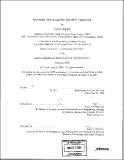| dc.contributor.advisor | Daniel E. Hastings. | en_US |
| dc.contributor.author | Joppin, Carole, 1979- | en_US |
| dc.contributor.other | Massachusetts Institute of Technology. Technology and Policy Program. | en_US |
| dc.date.accessioned | 2005-06-02T16:35:50Z | |
| dc.date.available | 2005-06-02T16:35:50Z | |
| dc.date.copyright | 2004 | en_US |
| dc.date.issued | 2004 | en_US |
| dc.identifier.uri | http://hdl.handle.net/1721.1/17660 | |
| dc.description | Thesis (S.M.)--Massachusetts Institute of Technology, Engineering Systems Division, Technology and Policy Program, 2004. | en_US |
| dc.description | Includes bibliographical references (p. 237-240). | en_US |
| dc.description.abstract | Except for manned servicing operations using the Shuttle, there is no maintenance infrastructure for space systems. The traditional approach is to build in reliability and to replace the system in case of obsolescence or failure. Space systems therefore offer a limited degree of flexibility to adapt to evolving conditions during their long design lifetimes. On-orbit servicing could change this paradigm by providing a physical access to the satellite after it has been deployed. Satellite upgrade appears as a very promising application. On-orbit servicing could offer a broader range of upgrades than current improvements through communication uploads and would be a cheaper alternative to satellite replacement. The attractiveness of on-orbit servicing for satellite upgrade is investigated from a customer point of view. A dynamic framework, based on Real Options and Decision Tree Analysis, is used to account for the value of the flexibility offered by on-orbit servicing. Two case studies are developed: a power upgrade on-board a commercial geosynchronous communication satellite facing an uncertain demand and technology upgrades on a scientific observatory. The power upgrade of a geosynchronous communication satellite is assumed to restore beginning of life power. The model shows that modifying the initial design of the satellite to compensate for power degradation is often preferred to on-orbit servicing because it offers a cheaper and less risky alternative. On-orbit servicing does not appear attractive in this case because the upgrade has a limited effect on satellite capacity and power degradation is a predictable phenomenon that can be partly overcome by design modifications. | en_US |
| dc.description.abstract | (cont.) Using the unique example of the Hubble Space Telescope servicing missions, the upgrade of the payload instruments and the bus subsystems on-board a scientific observatory is modelled. It is shown that satellite upgrades can significantly increase the utility of the mission, in particular if technology is evolving rapidly. It can be concluded from these two case studies that on-orbit servicing is viable and attractive if the increase in utility due to the upgrade is sufficiently large and if there is no other alternative that can offer a similar increase in utility at a lower cost or lower risk. Potential policy barriers to the acceptance of on-orbit servicing are identified and candidate policies are proposed to promote and enable the development of an on-orbit servicing infrastructure. A government intervention is likely to be necessary to overcome the risk averseness of the space industry and the "chicken and egg" problem arising from the necessity of designing the satellite for serviceability. | en_US |
| dc.description.statementofresponsibility | by Carole Joppin. | en_US |
| dc.format.extent | 240 p. | en_US |
| dc.format.extent | 13410765 bytes | |
| dc.format.extent | 13442287 bytes | |
| dc.format.mimetype | application/pdf | |
| dc.format.mimetype | application/pdf | |
| dc.language.iso | eng | en_US |
| dc.publisher | Massachusetts Institute of Technology | en_US |
| dc.rights | M.I.T. theses are protected by copyright. They may be viewed from this source for any purpose, but reproduction or distribution in any format is prohibited without written permission. See provided URL for inquiries about permission. | en_US |
| dc.rights.uri | http://dspace.mit.edu/handle/1721.1/7582 | |
| dc.subject | Technology and Policy Program. | en_US |
| dc.title | On-orbit servicing for satellite upgrades | en_US |
| dc.type | Thesis | en_US |
| dc.description.degree | S.M. | en_US |
| dc.contributor.department | Massachusetts Institute of Technology. Engineering Systems Division | |
| dc.contributor.department | Technology and Policy Program | |
| dc.identifier.oclc | 55636332 | en_US |
